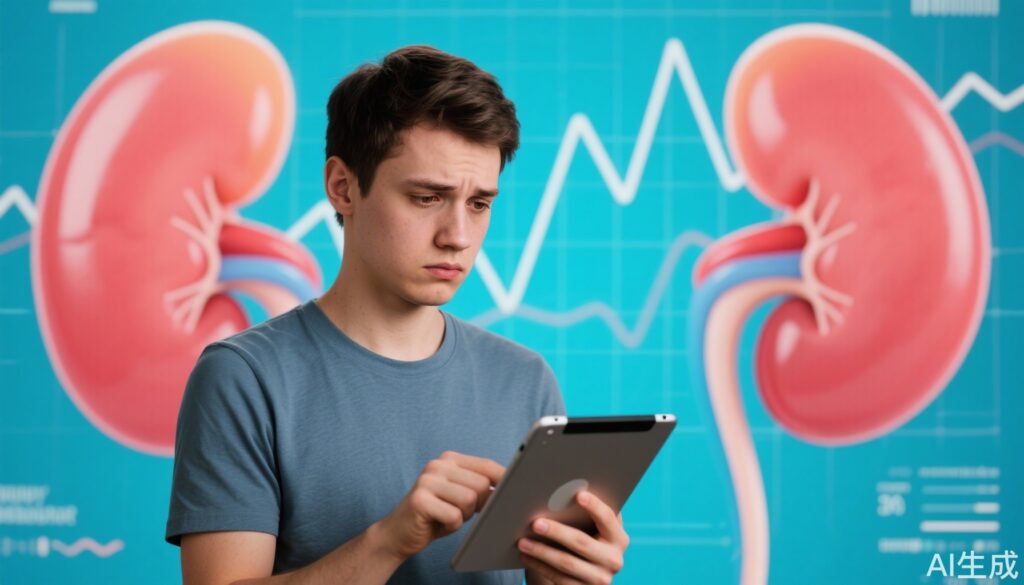Introduction: A Growing Health Concern Among the Young
Chronic kidney disease (CKD) is a silent epidemic, affecting approximately 10.8% of the Chinese population, and alarmingly, about 40% of patients with uremia are between the ages of 10 and 30. Uremia, a condition once considered a disease primarily of older adults, is quietly encroaching on younger generations. This trend signals a pressing public health issue that demands awareness, early detection, and proactive prevention.
The kidneys, often hailed as the body’s “cleaning service,” play a pivotal role in filtering toxins from the blood, regulating blood pressure, and maintaining the body’s electrolyte and acid-base balance. When these vital organs fail to perform their functions, waste accumulates, resulting in uremia — a critical, life-threatening stage of kidney failure.
Understanding Uremia: More Than Just “Kidneys Not Working”
Uremia is not a distinct illness but a clinical syndrome that marks the terminal phase of various advanced kidney disorders. It occurs when kidney function declines below 15% of the normal threshold, rendering the body incapable of eliminating metabolic waste and surplus fluids. The resulting toxin buildup causes severe systemic symptoms.
In China alone, over 120 million people suffer from chronic kidney disease, with between 1 to 2 million patients requiring kidney replacement therapy such as dialysis or transplantation. Alarmingly, the prevalence is rising roughly 8% annually. Despite this, awareness remains disturbingly low, with only 12.5% of patients informed of their condition. This indicates that nearly 9 out of 10 individuals with CKD are unaware they are at risk for uremia.
The Kidney: The Body’s Tireless “Waste Treatment Plant”
The kidneys are remarkable organs working tirelessly around the clock. Each day, they filter about 180 liters of blood, producing roughly 1.5 liters of urine. Their key functions include:
1. Blood filtration: Removing metabolic wastes and toxins.
2. Excretion: Clearing foreign substances and waste products.
3. Balance regulation: Maintaining fluid, electrolytes, and acid-base equilibrium.
4. Endocrine roles: Producing erythropoietin to stimulate red blood cells, regulating blood pressure via the renin-angiotensin system, and activating vitamin D.
Kidneys have robust compensatory abilities; they can maintain near-normal function until over half of the filtering units (nephrons) are lost. This compensation explains the often silent progression of kidney diseases—symptoms only appear when significant irreversible damage is present.
Why Is Uremia Striking the Young? Hidden Dangers at Work
Several factors contribute to the premature onset of uremia among young individuals:
1. Hypertension and Diabetes: The Leading Killers of Kidney Function
– Hypertension: Chronic high blood pressure damages the delicate blood vessels of the glomeruli (kidney filtering units), impairing filtration capacity.
– Diabetes: Elevated blood glucose harms the glomerular filtration membrane, leading to diabetic nephropathy, which is responsible for over 40% of uremia cases.
2. Unhealthy Lifestyles: Self-induced Kidney Injury
– High salt and fat diets increase the burden on kidney filtration.
– Chronic sleep deprivation disrupts hormonal and immune balance, promoting inflammation.
– Abuse of medications with nephrotoxic potentials, such as certain analgesics and antibiotics like gentamicin, accelerates kidney damage.
– Habitual urine retention fosters urinary infections and pyelonephritis, eventually triggering kidney failure.
3. Metabolic Syndrome: The Invisible “Toxin Bomb”
Obesity, hyperuricemia (elevated uric acid), and dyslipidemia (abnormal fats) injure the glomerular filtration membrane, acting as catalysts for uremia.
Recognizing Early Warning Signs: Don’t Ignore the Body’s SOS
Uremia evolves gradually, making early recognition critical for timely intervention.
Early Stage (Compensated Kidney Function):
– Increased nighttime urination (nocturia)
– Fatigue and decreased energy
– Loss of appetite
– Mild anemia
– Elevated blood pressure, especially in young adults
Middle Stage (Decompensation):
– Swelling around eyes and ankles (edema)
– Changes in urine output—either excess or decreased volume
– Itchy skin
– Muscle cramps
– Sleep disturbances
Late Stage (Uremic Syndrome):
– Severe nausea, vomiting, loss of appetite
– Generalized swelling
– Difficulty breathing
– Ammonia scent on breath
– Confusion or coma
It is important to note many patients remain asymptomatic until over 70% of kidney function is lost, underscoring the need for routine screening among at-risk populations.
Who Are the High-Risk Candidates for Uremia?
The following groups require vigilant monitoring and preventive measures:
1. Diabetes patients – accounting for approximately 40% of uremia cases
2. Individuals with hypertension
3. Patients with chronic glomerulonephritis
4. Those with recurrent urinary tract infections or pyelonephritis
5. Long-term users of nephrotoxic drugs, including some analgesics, antibiotics, and certain herbal medicines
6. Individuals with a family history of kidney disease
7. Elderly persons experiencing natural age-related renal decline
Diagnosis: How Do Doctors Confirm Kidney Failure?
Medical evaluation for uremia typically involves:
– Blood Tests: Elevated serum creatinine and urea nitrogen levels reflect decreased kidney function.
– Estimated Glomerular Filtration Rate (eGFR): A key index measuring kidney filtration efficiency.
– Urine Analysis: Checks for proteinuria, red blood cells, and casts indicating kidney damage.
– Imaging: Ultrasound to assess kidney size and structural abnormalities.
– Kidney Biopsy: Confirms specific disease type and severity.
Treatment: Not Helpless Against Uremia
Though uremia is serious, effective treatments have improved survival and quality of life:
1. Dialysis Therapy
– Hemodialysis: Blood is filtered through a machine 2-3 times weekly for about 4 hours per session.
– Peritoneal Dialysis: Dialysis fluid is introduced into the abdominal cavity daily to cleanse blood, with the convenience of home treatment.
2. Kidney Transplantation
This is the ideal treatment, offering improved survival and lifestyle but is challenged by donor shortages and potential immune rejection.
Financial Burden of Treatment
Uremia treatment is costly: annual hemodialysis expenses run between 80,000-100,000 RMB, kidney transplantation surgery costs about 200,000-300,000 RMB, and post-transplant immunosuppressants add 50,000-80,000 RMB annually. Despite insurance coverage, these costs impose heavy burdens on families.
Prevention: Protecting Your Kidneys Starts Today
Daily Kidney Care Practices:
– Morning: Drink 200ml warm water with 5ml apple cider vinegar to stimulate kidney activity.
– Midday: Take 15 minutes for meditation to lower cortisol and alleviate kidney stress.
– Evening: Walk briskly for 30 minutes to enhance filtration blood flow.
– Before Bed: Soak feet in 40°C water for 15 minutes to improve renal circulation.
– Weekly: Adopt one vegetarian day to reduce kidney metabolic load.
Dietary Guidance — The Red, Yellow, Green Light System:
| Food Category | Examples | Advice |
| — | — | — |
| Green Light (Beneficial) | Winter melon (diuretic), broccoli (contains protective glucosinolates), cherries (manage uric acid) | Encourage regular consumption |
| Yellow Light (Moderation) | Bananas (limit when potassium is high), tofu (limit phosphorus intake) | Consume cautiously according to health status |
| Red Light (Avoid) | Starfruit (contains neurotoxins), strong tea (oxalate crystals), processed meats | Avoid intake to prevent kidney harm |
Tailored Management for High-Risk Groups:
– Diabetes: Daily staple intake limited to under 200g, prioritizing buckwheat and oats.
– Hypertension: Adopt DASH diet with daily sodium under 1500 mg.
– Gout Patients: Avoid organ meats and seafood, increase water intake to over 2500 ml daily.
Common Misconceptions About Uremia
| Misconceptions | Truths |
| — | — |
| 1. Uremia always requires a kidney transplant | 80% of patients maintain life via dialysis; transplantation is performed in fewer than 5% due to constraints |
| 2. Dialysis is addictive | Dialysis substitutes kidney function; it’s temporary in cases where kidney function recovers |
| 3. Kidney failure patients should avoid exercise | Appropriate activities like Tai Chi and swimming improve anemia and muscle wasting |
Expert Insight
Dr. Mei Ling, Nephrologist, Beijing Medical University, emphasizes: “The asymptomatic nature of early kidney disease makes regular screening essential, especially in high-risk populations. Lifestyle modifications combined with timely medical intervention can dramatically alter disease trajectories.”
Patient Scenario: Meet John
John, a 28-year-old software engineer with poorly controlled diabetes and high blood pressure, began experiencing increased nighttime urination and fatigue but ignored these signs. After a routine check-up uncovered elevated serum creatinine and reduced eGFR, he was diagnosed with stage 4 CKD. With physician guidance, John adopted dietary changes, regular exercise, and medication adherence, significantly slowing disease progression and delaying dialysis need.
Conclusion
Uremia is no longer a condition confined to the elderly; its rising incidence among younger adults necessitates urgent attention. Public awareness, early detection, and preventive lifestyle changes are critical to combating this silent threat. While medical interventions exist to manage advanced disease, preventing progression from the outset remains the most effective strategy for preserving kidney health and quality of life.
References
1. Zhang L, Wang F, Wang L, et al. Prevalence of chronic kidney disease in China: a cross-sectional survey. Lancet. 2012;379(9818):815-822.
2. National Kidney Foundation. KDOQI Clinical Practice Guidelines for Chronic Kidney Disease: Evaluation, Classification, and Stratification. Am J Kidney Dis. 2002;39(2 Suppl 1):S1-266.
3. Wei Q, Miao L, Chen F, et al. Impact of diabetes and hypertension on chronic kidney disease progression in South China: a population-based study. Nephrol Dial Transplant. 2019;doi:10.1093/ndt/gfz307.
4. Kidney Disease: Improving Global Outcomes (KDIGO) CKD Work Group. KDIGO 2021 Clinical Practice Guideline for the Management of Blood Pressure in CKD. Kidney Int. 2021;99(3S):S1-S87.
5. US National Library of Medicine. MedlinePlus: Uremia. https://medlineplus.gov/ency/article/000489.htm (Accessed June 2024).



